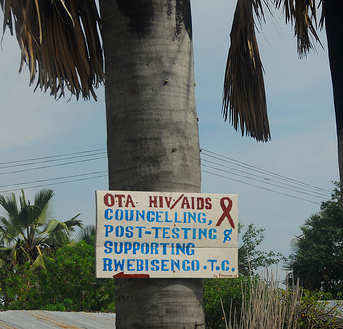This Week in PLOS Medicine: HIV Elimination and TB Diagnostics
This week, PLOS Medicine publishes the following new articles:

Using nine increasingly sophisticated mathematical models, Jan Hontelez from Erasmus MC, University Medical Center Rotterdam, Netherlands, and colleagues tested the time frames in which expanded access to antiretroviral viral therapy could lead to HIV elimination in South Africa. The current antiretroviral treatment policy in South Africa could lead to elimination of HIV within the country over the next 24 to 34 years, but a universal test and treat (UTT) approach could achieve elimination 10 years earlier, according to the research. All of the researchers’ models replicated the prevalence of HIV in South Africa (the proportion of the population that was HIV-positive) between 1990 and 2010, and all predicted that UTT would result in HIV elimination (less than one new infection per 1,000 person-years). The simplest model predicted that UTT would eliminate HIV after seven years, but the more complex, realistic models predicted elimination at much later time points. The most comprehensive model predicted that although elimination would be reached after about 17 years of UTT, the current strategy of ART initiation for HIV-positive individuals at a CD4 cell count at or below 350 cells/μl would also lead to HIV elimination, albeit ten years later than UTT.
In a related Perspective article Nathan Ford and Gottfried Hirnschall from the World Health Organization reflect on the research, noting, “[t]he case for ART impact on HIV transmission is proven. The priority now is to help translate this concept into benefits for patients and communities by identifying and implementing approaches that work to maximize early HIV testing and ART uptake and long-term retention in care.”
Despite the curability and preventability of TB, approximately 1.4 million people died because of the disease in 2011 according to the World Health Organization. TB infections remain one of the leading causes of death in people infected with HIV. One of the challenges for clinicians is correctly diagnosing TB, as the signs and symptoms may be similar to those of other diseases and current TB diagnostics have substantial limitations. Michael Levin and colleagues, from Imperial College London, aimed to identify a host blood RNA transcriptional signature that could form the basis of a simple diagnostic test. The researchers took blood samples from 584 adult patients with suspected TB in South Africa and Malawi and analysed their blood transcriptional profiles to identify signatures that could be used to calculate a disease risk score capable of differentiating TB from other conditions. The patients were eventually diagnosed with either TB, latent TB or another disease (thereby successfully excluding TB). While the results are promising, the authors acknowledge that further work is required before the findings can be used in the clinic.
In a related Perspective article Adithya Cattamanchi and colleagues, from the University of California San Francisco, reflect on the research noting, “Levin and colleagues have provided compelling proof of the concept that a blood transcriptional signature can distinguish between TB and clinical mimics in high-incidence settings. The field can now move on to asking more practical questions to determine the feasibility and optimal use for an RNA expression-based biomarker for TB in clinical settings.”
Tuberculous meningitis (TBM) is a serious and often fatal illness that is difficult to diagnose, particularly in resource-poor areas, and is especially common in individuals infected with HIV. Xpert MTB/RIF is a new DNA test that can be used in resource-poor settings and has generally been used to detect TB lung infections in sputum. Vinod B. Patel and colleagues from University of KwaZulu-Natal, Durban, South Africa, and University of Cape Town, South Africa, carried out a study to see whether Xpert MTB/RIF could detect TB DNA in the cerebrospinal fluid of patients with TB meningitis. Practical questions such as how much cerebrospinal fluid needs to be collected and how the sample needs to be processed were also considered. They performed the study in 204 South African patients with a meningeal-like illness, of whom 87% were HIV-infected. Standard diagnostic tests were used to categorize these patients as either definitely having TBM, possibly having TBM, or definitely not having TBM. Among patients infected with HIV, the Xpert MTB/RIF correctly identified 62% of those with TBM and 95% of those without TBM. The test did not perform well in the few individuals who were not HIV-infected. The authors conclude that Xpert MTB/RIF may be a good rule-in test for the diagnosis of TBM in HIV-infected individuals from a tuberculosis-endemic setting, particularly when a centrifuged CSF pellet is used. Further studies are required to confirm these findings in different settings.
In a related Perspective, David Boulware of the Division of Infectious Diseases and International Medicine, Department of Medicine, University of Minnesota, Minneapolis, Minnesota, states “Tuberculous meningitis (TBM) is characterized by copious cerebrospinal fluid (CSF) inflammation and yet few Mycobacterium tuberculosis. This combination creates a disease that is notoriously difficult to definitively diagnose…Xpert MTB/RIF appears to be a highly useful test to “rule in” the diagnosis of TBM, yet the clinical acumen of physicians remains a necessity for the wise use of any new diagnostic test. Careful application of these new diagnostic tools should improve clinicians’ ability to deliver timely, cost-effective care to patients with suspected TBM throughout the world, an approach that future studies should systematically evaluate.”
